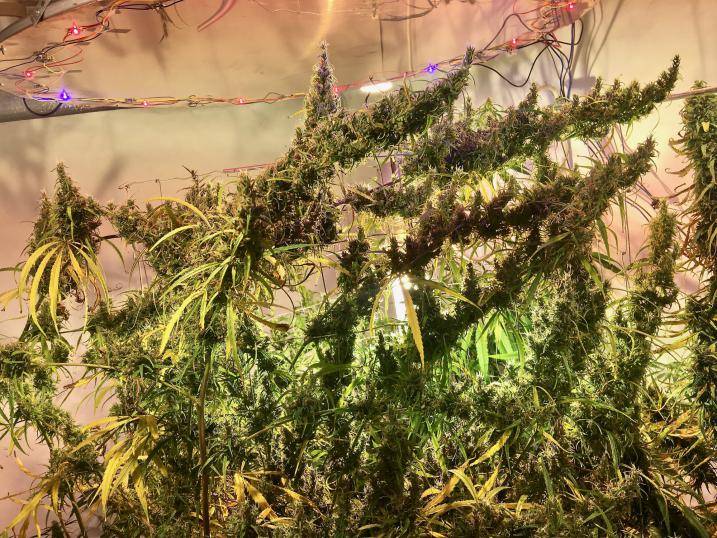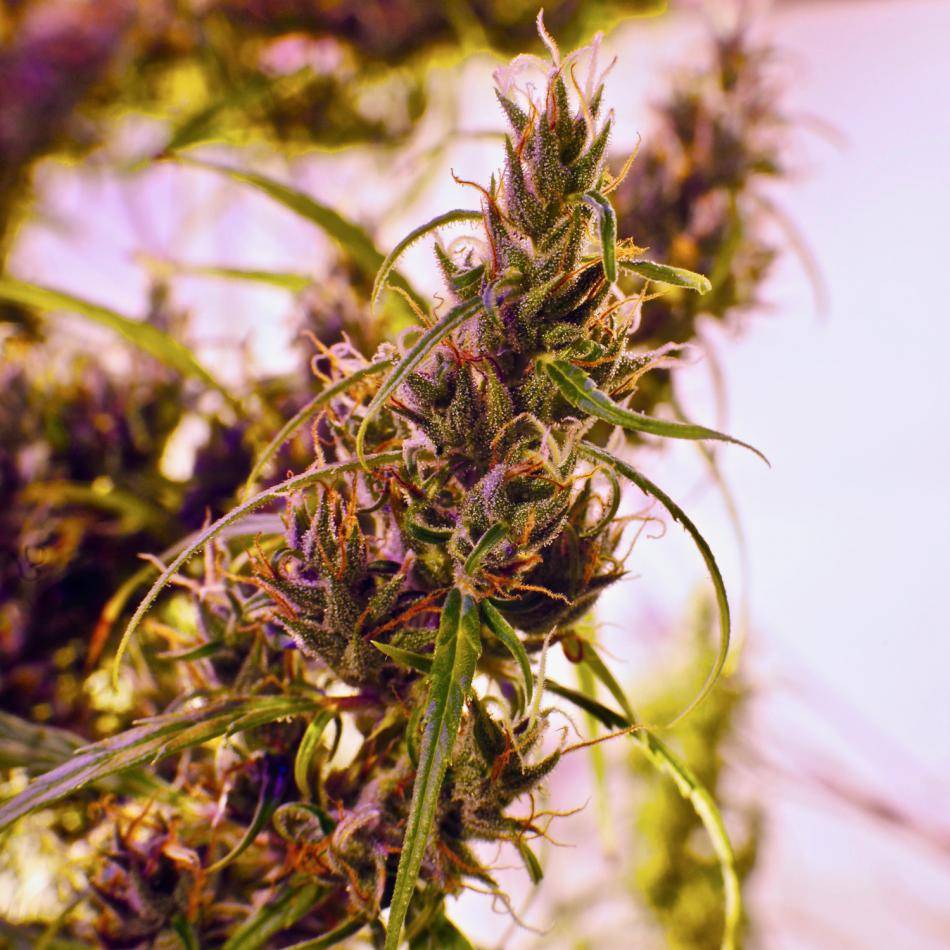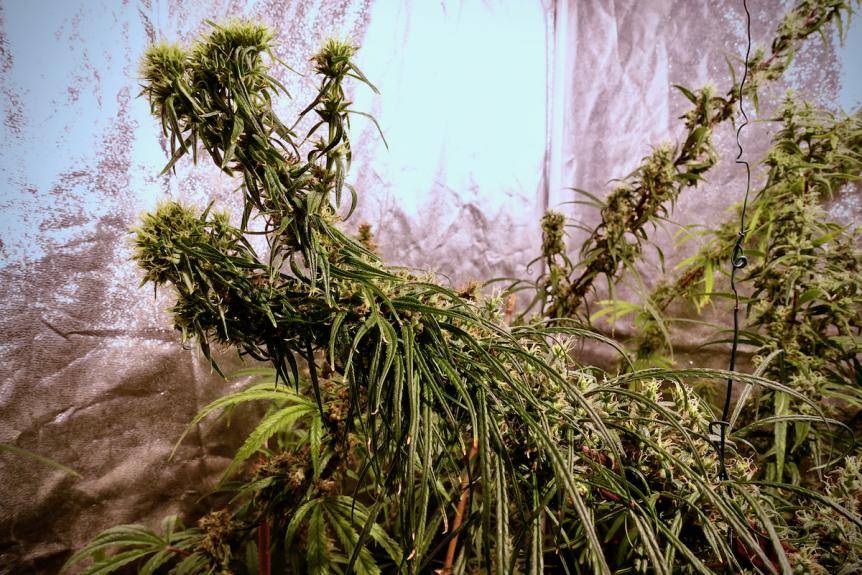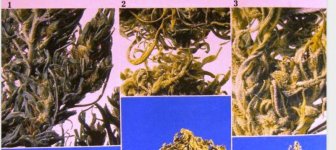-
ICMag with help from Phlizon, Landrace Warden and The Vault is running a NEW contest for Christmas! You can check it here. Prizes are: full spectrum led light, seeds & forum premium access. Come join in!
You are using an out of date browser. It may not display this or other websites correctly.
You should upgrade or use an alternative browser.
You should upgrade or use an alternative browser.
question for sam the skunkman on the original haze
- Thread starter bigherb
- Start date
TheDarkStorm
Well-known member
Very good find hempy...do you know wat year the articles from.?
TheDarkStorm
Well-known member
Dr young...do you find zamal tastes and smells strongly like haze.
Last edited:
Ive always liked Sam, and never doubted his words.
It may be that Columbian Gold was used in the mix. Ive always doubted red was used because of the heavy high.
It may be that there were more then one set of Haze Brothers. I don't know.
I feel fortunate to have met Nevil online, been taken under his wing so to speak, and the hours of conversations on Skype with him. and to have been the recipient of his Grail crosses before anyone else. Those seeds have a special place in my collection. My sons bucked the buds off a NH x Oax today. A real beauty.
Hopefully one of these years, I will be able to meet up with some of the members in this thread and smoke a spliff of haze together.
I did at least 50 crosses this year. Large branches. Hazes to Hazes, Hazes to Kush/Indicas, and Hazes to Sativas.
I hope we can all be kind to one another in our quest for information on a plant we all love
It may be that Columbian Gold was used in the mix. Ive always doubted red was used because of the heavy high.
It may be that there were more then one set of Haze Brothers. I don't know.
I feel fortunate to have met Nevil online, been taken under his wing so to speak, and the hours of conversations on Skype with him. and to have been the recipient of his Grail crosses before anyone else. Those seeds have a special place in my collection. My sons bucked the buds off a NH x Oax today. A real beauty.
Hopefully one of these years, I will be able to meet up with some of the members in this thread and smoke a spliff of haze together.
I did at least 50 crosses this year. Large branches. Hazes to Hazes, Hazes to Kush/Indicas, and Hazes to Sativas.
I hope we can all be kind to one another in our quest for information on a plant we all love
There is part of the story where Nevil wrote about the seeds he bought from Sam
And only 5 something like that germinated 1 female that flowered on and on he thought was great but eventually chopped and rest males
The males used for the hybrids nevilles haze etc etc
My point is out of how many seeds a kilo? over 1000 seeds
Seems like and some have put it out there that the seeds Nevil got from sam were possibly made by haze bros
That would explain the low germination rate and pheno types in Nevilles haze
I really dont know Sam would know if they were old seeds he brought over the pond or not but its interesting dimension to consider for sure
This has many sides and many facets Its got many possible correct answers including thai and s. indian Even a little bit back in the gene pool can be expressed one way or another It is possible
And of course Elite Colombian greens and silver blues and purples reds golds
Here's one more from SamS
preserved and recovered by bigherb
Quote:
The very first original Haze was a late 60's three way cross of Colombian Punto Rojo, a green one, and a light magenta one, all different, all from Columbia, several years later I gave Thai and S Indian seeds that were also crossed to Haze, I had seeds of all of them, Original Haze, and Original Haze X Thai from off the stick gold Thai about 76 in Santa Cruz , called Laos at the time.
I spread the seeds around Cali etc and I brought the seeds with me to the Netherlands and used them to select clone parents for my unimproved Haze lines I preserved, I did not do much work to improve Haze I was trying to preserve it. The Thai and S Indiana Kerala X O Haze crosses were made by my neighbor, R.L. the junior O Haze grower that made the O Haze poster, as I did not grow much Haze until the next year. So anyway it is now pretty hard to tell but what most have was pure Colombian, green, purple, lime green, silver, magenta, blueish, I saw all this before Haze had anything besides Colombian in it. A little bit has Thai, and even less has S Indian. I will be testing the*DNA*of my Haze lines and clones, then we will maybe have answers about what they is and isn't, and maybe where all the best Cannabis in Colombia, Jamaica, Mexico came from? India, Africa? Asia? Time will tell.
I have found that my line is fairly inbred as it was not out-crossed except for the Thai and S Indian one year, and that was just a few plants. Most are just pure Original Haze Colombian, with no WLD Wide Leaf Drug (was called Indica) genes, zero. Because it is inbred if you do if you do outcross it the qualities are improved like vigor and potency. I have done this and seen where 16%*THC*Mom Skunk 1, X a 10%*THC*O Haze gives progeny in the 20's for*THC%, try it, you will see what I mean.
P.S. I found Purple Haze to be the strongest, but the silver-blue and lime-green ones where the high I preferred, purple Haze was more physical also.
Up, clear, electric, speedy,*cerebral, mental, energetic, euphoric, psychedelic, no ceiling, every hit gets you higher every time, the kind of Cannabis that gets people turning white, passing out or falling over when they stand, and getting paranoid. Some of you may prefer the same, I can tell. I have never gotten too high, I have gotten to high to walk, that's what chaise lounge sofas, Lazy-Boys and the floor were invented for. I could still smoke.....
If Yo Sammy sends me a dry leaf of his old NH cuttings that is being kept in South Holland I could test it also and maybe see the NL genes in it? PM me.
-SamS
https://www.icmag.com/ic/showthread.php?t=82182&page=145
And only 5 something like that germinated 1 female that flowered on and on he thought was great but eventually chopped and rest males
The males used for the hybrids nevilles haze etc etc
My point is out of how many seeds a kilo? over 1000 seeds
Seems like and some have put it out there that the seeds Nevil got from sam were possibly made by haze bros
That would explain the low germination rate and pheno types in Nevilles haze
I really dont know Sam would know if they were old seeds he brought over the pond or not but its interesting dimension to consider for sure
This has many sides and many facets Its got many possible correct answers including thai and s. indian Even a little bit back in the gene pool can be expressed one way or another It is possible
And of course Elite Colombian greens and silver blues and purples reds golds
Here's one more from SamS
preserved and recovered by bigherb
Quote:
The very first original Haze was a late 60's three way cross of Colombian Punto Rojo, a green one, and a light magenta one, all different, all from Columbia, several years later I gave Thai and S Indian seeds that were also crossed to Haze, I had seeds of all of them, Original Haze, and Original Haze X Thai from off the stick gold Thai about 76 in Santa Cruz , called Laos at the time.
I spread the seeds around Cali etc and I brought the seeds with me to the Netherlands and used them to select clone parents for my unimproved Haze lines I preserved, I did not do much work to improve Haze I was trying to preserve it. The Thai and S Indiana Kerala X O Haze crosses were made by my neighbor, R.L. the junior O Haze grower that made the O Haze poster, as I did not grow much Haze until the next year. So anyway it is now pretty hard to tell but what most have was pure Colombian, green, purple, lime green, silver, magenta, blueish, I saw all this before Haze had anything besides Colombian in it. A little bit has Thai, and even less has S Indian. I will be testing the*DNA*of my Haze lines and clones, then we will maybe have answers about what they is and isn't, and maybe where all the best Cannabis in Colombia, Jamaica, Mexico came from? India, Africa? Asia? Time will tell.
I have found that my line is fairly inbred as it was not out-crossed except for the Thai and S Indian one year, and that was just a few plants. Most are just pure Original Haze Colombian, with no WLD Wide Leaf Drug (was called Indica) genes, zero. Because it is inbred if you do if you do outcross it the qualities are improved like vigor and potency. I have done this and seen where 16%*THC*Mom Skunk 1, X a 10%*THC*O Haze gives progeny in the 20's for*THC%, try it, you will see what I mean.
P.S. I found Purple Haze to be the strongest, but the silver-blue and lime-green ones where the high I preferred, purple Haze was more physical also.
Up, clear, electric, speedy,*cerebral, mental, energetic, euphoric, psychedelic, no ceiling, every hit gets you higher every time, the kind of Cannabis that gets people turning white, passing out or falling over when they stand, and getting paranoid. Some of you may prefer the same, I can tell. I have never gotten too high, I have gotten to high to walk, that's what chaise lounge sofas, Lazy-Boys and the floor were invented for. I could still smoke.....
If Yo Sammy sends me a dry leaf of his old NH cuttings that is being kept in South Holland I could test it also and maybe see the NL genes in it? PM me.
-SamS
https://www.icmag.com/ic/showthread.php?t=82182&page=145
He did tell me very few seeds germinated
I could have sworn I read Sam saying he was the one who created Haze (or was it skunk?). Can someone correct me?
I could have sworn I read Sam saying he was the one who created Haze (or was it skunk?). Can someone correct me?
Skunk #1
@hempy
The Haze Whisperer
I love sativas and Haze is special that is one thing all sides of this debate / conversation / and some times heated conversation can agree on.
If you read the old articles you read the history the one thing that stands out is Haze was the first strain to be marketed it was the first branded cannabis line.So a little marketing a little myth mixed in is part of it.
If you read the old articles you read the history the one thing that stands out is Haze was the first strain to be marketed it was the first branded cannabis line.So a little marketing a little myth mixed in is part of it.
MadMac
far beyond driven...
THH OHZ & Zamal
THH OHZ & Zamal

if i compare my 12 Tom Hill Haze lady's to the 16 o-haze lady's
two different strains...
only some of the smell & high they have in common...
leaf's and bud's are different to all 16 o-haze girls i have harvested now...
also flowering time and stretch is different...
OHz flowers longer than THH and stretches more...
OHz is way more sensitive to fertilizer and not easy to finish proper indoors...
THH is made for indoors... max 14 weeks from clone and in general 12 weeks ... much easier to grow... not so sensitive to fertilizer...
the end product is with booth amazing...
but also different...
OHz is more clear than THH... THH can give a destroyed view and is more racy... what i like sometimes in the morning... like a strong coffee... but booth have the same psychedelic effect uplifting and motivating ... that i love... you want to do something...
Tom did a amazing job to breed for this acid high...
have 3 plants from 12 who have this mega racy psychedelic high...
but if you smoke it all day ... it becomes boring the 3'th day... and isn't special anymore... it's hard to track it down where it comes from... i always test those smoke on my friends... they do not smoke often...
THH is there fav with Zamal ... but they did not smoke the OHz until now... so maybe it will change...
Also the Zamal grows and flowers similar to OHz... has the same social high... but is not so strong and it works fantastic with woman..
they love the social smoke and can't stop talking after... can also be worth... depend on situation haha... if a woman talks when you have sex... forget it... ;-)
Zamal Mangu'Carrot... 18 weeks +


look @ the old pic's from @hemphy -> many thx for posting!
Haze is the result of humans taking the very finest sativas and crossing them selecting over generations, Zamal is also the result of crossing the very finest sativas, but with the selection done by nature, the plants that could grow and mature in their new location being those that through natural selection survived and passed their genes on to subsequent generations.
M.
fasciated OHz



@SamS
30+ years later and it's still hot discussed...
the fasciated is amazing smoke!
need more cure but first samples where impressive
it's another league ...
better smoke report and so will come late december...
thx
M.
THH OHZ & Zamal
thx!Hey mad mac stunning pictures....wat do you think of the seedsman sams haze compared to the tom hill haze..?
if i compare my 12 Tom Hill Haze lady's to the 16 o-haze lady's
two different strains...
only some of the smell & high they have in common...
leaf's and bud's are different to all 16 o-haze girls i have harvested now...
also flowering time and stretch is different...
OHz flowers longer than THH and stretches more...
OHz is way more sensitive to fertilizer and not easy to finish proper indoors...
THH is made for indoors... max 14 weeks from clone and in general 12 weeks ... much easier to grow... not so sensitive to fertilizer...
the end product is with booth amazing...
but also different...
OHz is more clear than THH... THH can give a destroyed view and is more racy... what i like sometimes in the morning... like a strong coffee... but booth have the same psychedelic effect uplifting and motivating ... that i love... you want to do something...
Tom did a amazing job to breed for this acid high...
have 3 plants from 12 who have this mega racy psychedelic high...
but if you smoke it all day ... it becomes boring the 3'th day... and isn't special anymore... it's hard to track it down where it comes from... i always test those smoke on my friends... they do not smoke often...
THH is there fav with Zamal ... but they did not smoke the OHz until now... so maybe it will change...
Also the Zamal grows and flowers similar to OHz... has the same social high... but is not so strong and it works fantastic with woman..
they love the social smoke and can't stop talking after... can also be worth... depend on situation haha... if a woman talks when you have sex... forget it... ;-)
Zamal Mangu'Carrot... 18 weeks +
look @ the old pic's from @hemphy -> many thx for posting!
Haze is the result of humans taking the very finest sativas and crossing them selecting over generations, Zamal is also the result of crossing the very finest sativas, but with the selection done by nature, the plants that could grow and mature in their new location being those that through natural selection survived and passed their genes on to subsequent generations.
M.
fasciated OHz
@SamS
30+ years later and it's still hot discussed...
the fasciated is amazing smoke!
need more cure but first samples where impressive
it's another league ...
better smoke report and so will come late december...
thx
M.
haha 
This is better to watch on your cellphone.

When we take a look to the history of the Colombian varieties.
When we take a look to the history of the Colombian varieties.
“Marijuana arrived in Colombia thanks to the aid of the USA in 1930. Seven years before the USA made Marijuana illegal.. In 1930 the department of agriculture of the United States (USDA) created a project to promote the different uses of marijuana. United States knew that marijuana had immense medicinal potential and industrial. The USA did not want to use American lands so they decided to go to Colombia to develop the project. The Marijuana utilized for this project was brought from The Island of Borneo. Borneo and Colombia are very similar countries in question of environment. Both countries are situated in tropical rainy forests, the perfect environment to grow Marijuana and for this reason the USA chose Colombia for the project. Colombia is a very tropical country. In1937 the USA made Marijuana illegal. The projects were canceled. The gringos that were working in Colombia on the project had to return but they never destroyed the plants. They left the ones that were working with in Colombia.”
JohnnyChicago
Well-known member
then we come to the next question, with the most favorable laws will the seeds of original haze be back on the market? (not the tfd hybrids, I mean pure original haze)
You wrote the response yourself
@JohnnyChicago, cultivating a long-flowering sativa, like original haze, is madness: a very long wait, a not too abundant harvest (usually), and an effect that many do not like...
(and we know it well because we are among those crazy people who grow up and love haze) ...
I don't think there is enough money to be earned with us crazy people. There's not enough market. Working/breeding such strains is also to work intensive. And also subject to many customer complaints or custumer unsatisfaction, like we have seen with the Seedsman Haze the 2 last decades were almost all the reports were negative. And now in the Instagram era, it would be even worse. Nowadays everything must be quick and easy, everywhere not only in the canna business. But who knows what will happen in the future. If you ask me, I think we will see new O Haze offerings being released from the illegal market first.
View Image
thx!
if i compare my 12 Tom Hill Haze lady's to the 16 o-haze lady's
two different strains...
only some of the smell & high they have in common...
leaf's and bud's are different to all 16 o-haze girls i have harvested now...
also flowering time and stretch is different...
OHz flowers longer than THH and stretches more...
OHz is way more sensitive to fertilizer and not easy to finish proper indoors...
THH is made for indoors... max 14 weeks from clone and in general 12 weeks ... much easier to grow... not so sensitive to fertilizer...
the end product is with booth amazing...
but also different...
OHz is more clear than THH... THH can give a destroyed view and is more racy... what i like sometimes in the morning... like a strong coffee... but booth have the same psychedelic effect uplifting and motivating ... that i love... you want to do something...
Tom did a amazing job to breed for this acid high...
have 3 plants from 12 who have this mega racy psychedelic high...
but if you smoke it all day ... it becomes boring the 3'th day... and isn't special anymore... it's hard to track it down where it comes from... i always test those smoke on my friends... they do not smoke often...
THH is there fav with Zamal ... but they did not smoke the OHz until now... so maybe it will change...
Also the Zamal grows and flowers similar to OHz... has the same social high... but is not so strong and it works fantastic with woman..
they love the social smoke and can't stop talking after... can also be worth... depend on situation haha... if a woman talks when you have sex... forget it... ;-)
Zamal Mangu'Carrot... 18 weeks +
View Image
View Image
look @ the old pic's from @hemphy -> many thx for posting!
Haze is the result of humans taking the very finest sativas and crossing them selecting over generations, Zamal is also the result of crossing the very finest sativas, but with the selection done by nature, the plants that could grow and mature in their new location being those that through natural selection survived and passed their genes on to subsequent generations.
M.
fasciated OHz
View Image
View Image
@SamS
30+ years later and it's still hot discussed...
the fasciated is amazing smoke!
need more cure but first samples where impressive
it's another league ...
better smoke report and so will come late december...
thx
M.
I also like more these indica mixes to pure jungle haze dominant strains so that is why I had bad expirience with TFD O haze from past it was pure haze about 2000s.
THH is like NH and old MNS seeds compared to O hazes.
So that is why you told me that in THH you can find esier good haze pheno.
I need haze high mostly with raciness and introspection of strongest indicas and these kind of high i found my holly grails.
Beutiful plants that o haze, but its look like my old TFD O haze more jungly than hybridised like THH pictures. Also resin comes quick in THH like best sativa phenos from MNS haze seed stock.
Get Hazed,I am

This is better to watch on your cellphone.View Image
When we take a look to the history of the Colombian varieties.
We have discussed this in the past , it’s very interesting
We should also consider the Atlantic slave trade . Dating back to 1500’s African slaves from various areas such as Congo , Senegal , Angola , Nigeria Etc . We know Africa is probably the best place with unhybridized cannabis . There scared strains have been cultivated and still by tribesman and such . It seems very possible seed was brought by some of the million of slaves during these times
1luvbigherb
TheDarkStorm
Well-known member
Thanks for that mad mac...a very good description of the differences between tom hills haze and seedsmans haze..very usefull information for evryone.








